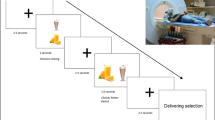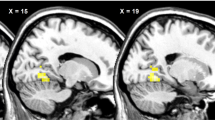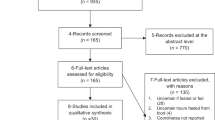Abstract
Background:
Stress results in eating in the absence of hunger, possibly related to food reward perception.
Hypothesis:
Stress decreases food reward perception.
Aim:
Determine the effect of acute stress on food choice and food choice reward-related brain activity.
Subjects:
Nine females (BMI=21.5±2.2 kg/m2, age=24.3±3.5 years).
Procedure:
Fasted subjects came twice to randomly complete either a rest or stress condition. Per session, two functional MRI scans were made, wherein the subjects chose the subsequent meal (food images). The rewarding value of the food was measured as liking and wanting. Food characteristics (for example, crispiness, fullness of taste and so on), energy intake, amount of each macronutrient chosen, plasma cortisol and Visual Analog Scale (VAS) hunger and satiety were measured.
Results:
Fasted state was confirmed by high hunger (80±5 mm VAS). Breakfast energy intake (3±1 MJ) and liking were similar in all conditions. Wanting was lower postprandially (Δ=−0.3 items/category, P<0.01). Breakfast decreased hunger (−42 mm VAS, P<0.01). Postprandially, energy intake (−1.1 MJ), protein intake (−14.7 g) and carbohydrate intake (−32.7 g all P<0.05) were lower. Fat intake was not different (−7.3, P=0.4). Putamen activity was not lower postprandially. Cortisol levels were increased in the stress condition (Area under the curve of cortisol: ΔAUC=+2.2 × 104 nmol min−1 l−1, P<0.05). Satiety was lower after breakfast (−8 mm VAS, P<0.01). Postprandial energy intake, protein intake and carbohydrate intake were relatively higher compared with the rest condition, resulting from more choice for crispiness and fullness of taste (P<0.05). Brain activation was reduced in reward areas: amygdala, hippocampus and cingulate cortex (AUC=−13.33, −1.34, −2.56% blood oxygen level dependent (BOLD) s for choosing breakfast and AUC=−9.31, −1.25, −2.34%BOLD s<0.05 for choosing the second meal). Putamen activation was decreased postprandially (AUC=−1.2%BOLD s, P<0.05).
Conclusion:
Reward signaling and reward sensitivity were significantly lower under stress, coinciding with increased energy intake from food choice for more crispiness and fullness of taste. The changes in putamen activation may reflect specifically decreased reward prediction sensitivity.
This is a preview of subscription content, access via your institution
Access options
Subscribe to this journal
Receive 12 print issues and online access
$259.00 per year
only $21.58 per issue
Buy this article
- Purchase on Springer Link
- Instant access to full article PDF
Prices may be subject to local taxes which are calculated during checkout




Similar content being viewed by others
References
James PT, Leach R, Kalamara E, Shayeghi M . The worldwide obesity epidemic. Obes Res 2001; 9 (Suppl 4): 228S–233S.
Despres JP, Lemieux I . Abdominal obesity and metabolic syndrome. Nature 2006; 444: 881–887.
Hutley L, Prins JB . Fat as an endocrine organ: relationship to the metabolic syndrome. Am J Med Sci 2005; 330: 280–289.
Epel ES, McEwen B, Seeman T, Matthews K, Castellazzo G, Brownell KD et al. Stress and body shape: stress-induced cortisol secretion is consistently greater among women with central fat. Psychosom Med 2000; 62: 623–632.
Kyrou I, Chrousos GP, Tsigos C . Stress, visceral obesity, and metabolic complications. Ann N Y Acad Sci 2006; 1083: 77–110.
Axelrod J, Reisine TD . Stress hormones: their interaction and regulation. Science 1984; 224: 452–459.
Eechaute W, Lacroix E, Leusen I . [Correlation between the plasma level of free Corticosterone and in vitro adrenal activity in the rat.]. Arch Int Physiol Biochim 1963; 71: 528–533.
Bjorntorp P, Rosmond R . Obesity and cortisol. Nutrition 2000; 16: 924–936.
Makimura H, Mizuno TM, Roberts J, Silverstein J, Beasley J, Mobbs CV . Adrenalectomy reverses obese phenotype and restores hypothalamic melanocortin tone in leptin-deficient ob/ob mice. Diabetes 2000; 49: 1917–1923.
Dallman MF, Strack AM, Akana SF, Bradbury MJ, Hanson ES, Scribner KA et al. Feast and famine: critical role of glucocorticoids with insulin in daily energy flow. Front Neuroendocrinol 1993; 14: 303.
Strack AM, Sebastian RJ, Schwartz MW, Dallman MF . Glucocorticoids and insulin: reciprocal signals for energy balance. Am J Physiol 1995; 268 (1 Pt 2): R142–R149.
la Fleur SE . The effects of glucocorticoids on feeding behavior in rats. Physiol Behav 2006; 89: 110–114.
la Fleur SE, Akana SF, Manalo SL, Dallman MF . Interaction between corticosterone and insulin in obesity: regulation of lard intake and fat stores. Endocrinology 2004; 145: 2174–2185.
Newman E, O’Connor DB, Conner M . Daily hassles and eating behaviour: the role of cortisol reactivity status. Psychoneuroendocrinology 2007; 32: 125–132.
Oliver G, Wardle J, Gibson EL . Stress and food choice: a laboratory study. Psychosom Med 2000; 62: 853–865.
Wardle J, Steptoe A, Oliver G, Lipsey Z . Stress, dietary restraint and food intake. J Psychosom Res 2000; 48: 195–202.
Drewnowski A, Krahn DD, Demitrack MA, Nairn K, Gosnell BA . Taste responses and preferences for sweet high-fat foods: evidence for opioid involvement. Physiol Behav 1992; 51: 371–379.
Elfhag K, Erlanson-Albertsson C . Sweet and fat taste preference in obesity have different associations with personality and eating behavior. Physiol Behav 2006; 88: 61–66.
Epel E, Lapidus R, McEwen B, Brownell K . Stress may add bite to appetite in women: a laboratory study of stress-induced cortisol and eating behavior. Psychoneuroendocrinology 2001; 26: 37–49.
Salbe AD, DelParigi A, Pratley RE, Drewnowski A, Tataranni PA . Taste preferences and body weight changes in an obesity-prone population. Am J Clin Nutr 2004; 79: 372–378.
Berthoud HR . Neural control of appetite: cross-talk between homeostatic and non-homeostatic systems. Appetite 2004; 43: 315–317.
Westerterp KR, Speakman JR . Physical activity energy expenditure has not declined since the 1980s and matches energy expenditures of wild mammals. Int J Obes 2008; 32: 1256–1263.
Rutters F, Nieuwenhuizen AG, Lemmens SGT, Born JM, Westerterp-Plantenga MS . Acute stress-related changes in eating in the absence of hunger. Obesity 2009; 17: 72–77.
Berridge KC . Food reward: brain substrates of wanting and liking. Neurosci Biobehav Rev 1996; 20: 1–25.
Gottfried JA, O’Doherty J, Dolan RJ . Encoding predictive reward value in human amygdala and orbitofrontal cortex. Science 2003; 301: 1104–1107.
O’Doherty JP . Reward representations and reward-related learning in the human brain: insights from neuroimaging. Curr Opin Neurobiol 2004; 14: 769–776.
Stice E, Spoor S, Bohon C, Small DM . Relation between obesity and blunted striatal response to food is moderated by TaqIA A1 allele. Science 2008; 322: 449–452.
Del Parigi A, Gautier JF, Chen K, Salbe AD, Ravussin E, Reiman E et al. Neuroimaging and obesity: mapping the brain responses to hunger and satiation in humans using positron emission tomography. Ann N Y Acad Sci 2002; 967: 389–397.
Gautier JF, Del Parigi A, Chen K, Salbe AD, Bandy D, Pratley RE et al. Effect of satiation on brain activity in obese and lean women. Obes Res 2001; 9: 676–684.
Matsuda M, Liu Y, Mahankali S, Pu Y, Mahankali A, Wang J et al. Altered hypothalamic function in response to glucose ingestion in obese humans. Diabetes 1999; 48: 1801–1806.
Small DM, Jones-Gotman M, Dagher A . Feeding-induced dopamine release in dorsal striatum correlates with meal pleasantness ratings in healthy human volunteers. Neuroimage 2003; 19: 1709–1715.
Wang GJ, Volkow ND, Logan J, Pappas NR, Wong CT, Zhu W et al. Brain dopamine and obesity. Lancet 2001; 357: 354–357.
Czyrak A, Mackowiak M, Chocyk A, Fijal K, Wedzony K . Role of glucocorticoids in the regulation of dopaminergic neurotransmission. Pol J Pharmacol 2003; 55: 667–674.
Pani L, Porcella A, Gessa GL . The role of stress in the pathophysiology of the dopaminergic system. Mol Psychiatry 2000; 5: 14–21.
Pruessner JC, Champagne F, Meaney MJ, Dagher A . Dopamine release in response to a psychological stress in humans and its relationship to early life maternal care: a positron emission tomography study using raclopride. J Neurosci 2004; 24: 2825–2831.
Salamone JD, Cousins MS, Snyder BJ . Behavioral functions of nucleus accumbens dopamine: empirical and conceptual problems with the anhedonia hypothesis. Neurosci Biobehav Rev 1997; 21: 341–359.
Fulton S, Richard D, Woodside B, Shizgal P . Interaction of CRH and energy balance in the modulation of brain stimulation reward. Behav Neurosci 2002; 116: 651–659.
Stunkard AJ, Messick S . The three-factor eating questionnaire to measure dietary restraint, disinhibition and hunger. J Psychosom Res 1985; 29: 71–83.
Peters ML, Godaert GL, Ballieux RE, van Vliet M, Willemsen JJ, Sweep FC et al. Cardiovascular and endocrine responses to experimental stress: effects of mental effort and controllability. Psychoneuroendocrinology 1998; 23: 1–17.
Lemmens SGT, Schoffelen PFM, Wouters L, Born JM, Martens MJI, Rutters F et al. Eating what you like induces a stronger decrease of ‘wanting’ to eat. Physiology & Behavior 2009; 98: 318–325.
Talairach J, Tournoux P . Co-Planar Stereotaxic Atlas of the Human Brain. Thieme: Stuttgart, 1988.
Schultz W, Apicella P, Scarnati E, Ljungberg T . Neuronal activity in monkey ventral striatum related to the expectation of reward. J Neurosci 1992; 12: 4595–4610.
Ramnani N, Owen AM . Anterior prefrontal cortex: insights into function from anatomy and neuroimaging. Nat Rev Neurosci 2004; 5: 184–194.
Schultz W . Reward signaling by dopamine neurons. Neuroscientist 2001; 7: 293–302.
Haruno M, Kawato M . Different neural correlates of reward expectation and reward expectation error in the Putamen and Caudate nucleus during stimulus-action-reward association learning. J Neurophysiol 2006; 95: 948–959.
Hollerman JR, Tremblay L, Schultz W, Uylings HBM, Eden GGv, Bruin JPCd et al. Involvement of basal ganglia and orbitofrontal cortex in goal-directed behavior. Prog Brain Res 2000; 126: 193–215.
Acknowledgements
We gratefully acknowledge S Verhoef for help with the practical work, P Schoffelen for his contribution regarding the technical realization of the scan paradigm and the synchronization with the scanner, S Gijsen for essential help and input concerning the fMRI scanner and A Heinecke for his extensive support for the analyses with BrainVoyager. Furthermore, we thank M Hulsbosch, W Sluismans and J Sulon for analyzing the serum and plasma hormone samples.
Author information
Authors and Affiliations
Corresponding author
Additional information
Author contribution
JMB conducted the experiment, including fMRI, developed the fMRI data analysis, analyzed the data and wrote the manuscript. SGTL conducted the experiment, assisted with fMRI and reviewed the manuscript and developed the liking and wanting paradigm. FR advised on the fMRI paradigm and reviewed the manuscript. AGN advised on the setup of the experiment concerning the acute stress paradigm and reviewed the manuscript. EF and RG advised on the setup of the fMRI paradigm, data analysis and reviewed the manuscript. MSWP conceived the experiment and developed the liking and wanting paradigm reviewed the manuscript.
Rights and permissions
About this article
Cite this article
Born, J., Lemmens, S., Rutters, F. et al. Acute stress and food-related reward activation in the brain during food choice during eating in the absence of hunger. Int J Obes 34, 172–181 (2010). https://doi.org/10.1038/ijo.2009.221
Received:
Revised:
Accepted:
Published:
Issue Date:
DOI: https://doi.org/10.1038/ijo.2009.221
Keywords
This article is cited by
-
The influence of stress on the neural underpinnings of disinhibited eating: a systematic review and future directions for research
Reviews in Endocrine and Metabolic Disorders (2023)
-
Poorer mental health and sleep quality are associated with greater self-reported reward-related eating during pregnancy and postpartum: an observational cohort study
International Journal of Behavioral Nutrition and Physical Activity (2021)
-
Life history strategy and overeating during COVID-19 pandemic: a moderated mediation model of sense of control and coronavirus stress
Journal of Eating Disorders (2021)
-
The relative contributions of behavioral, biological, and psychological risk factors in the association between psychosocial stress and all-cause mortality among middle- and older-aged adults in the USA
GeroScience (2021)
-
Comparison of two questionnaires for assessment of emotional eating in people undergoing treatment for obesity
Eating and Weight Disorders - Studies on Anorexia, Bulimia and Obesity (2021)



